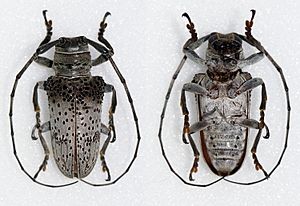Oncideres cephalotes facts for kids
Quick facts for kids Oncideres cephalotes |
|
|---|---|
 |
|
| Scientific classification | |
| Kingdom: | |
| Phylum: | |
| Class: | |
| Order: | |
| Suborder: | |
| Family: | |
| Genus: |
Oncideres
|
| Species: |
O. cephalotes
|
| Binomial name | |
| Oncideres cephalotes Bates, 1865
|
|
Oncideres cephalotes is a fascinating type of beetle! It belongs to a family called Cerambycidae, which are often known as "longhorn beetles." These beetles get their name from their super long antennae, which can sometimes be even longer than their bodies!
This specific beetle was first described by a scientist named Henry Walter Bates in 1865. You can find Oncideres cephalotes living in parts of South America, especially in Brazil and French Guiana.
Contents
What is Oncideres cephalotes?
Oncideres cephalotes is a member of the Oncideres genus. Beetles in this group are famous for a special skill. They are often called "twig girdlers" or "pruners." This is because the female beetles cut rings around tree branches. They do this before laying their eggs.
Why do they cut branches?
The female beetle uses her strong jaws, called mandibles, to chew a groove around a branch. This groove is deep enough to cut through the outer layers of the wood. It makes the branch weaker. After the branch is girdled, the beetle lays her eggs in it.
This action causes the branch to die and eventually fall off the tree. Why do they do this? The dying wood provides the perfect food and home for the beetle larvae when they hatch. It's a clever way to make sure their babies have enough to eat!
Where do these beetles live?
Oncideres cephalotes beetles live in tropical and subtropical forests. These areas are warm and humid. They have many different types of trees. Brazil and French Guiana are perfect homes for them. These countries have vast rainforests.
Their forest home
In these forests, Oncideres cephalotes can find many host trees. Host trees are the specific types of trees they like to lay their eggs on. Different species of Oncideres beetles prefer different kinds of trees. They might choose oak, pecan, or other hardwood trees.
Life Cycle of a Longhorn Beetle
Like all beetles, Oncideres cephalotes goes through a complete metamorphosis. This means it changes a lot during its life. It has four main stages: egg, larva, pupa, and adult.
Egg stage
The life cycle starts when the female beetle lays her tiny eggs. She places them inside the girdled branches. The eggs are usually laid in small holes she chews into the wood.
Larva stage
After a few days or weeks, the eggs hatch into larvae. These larvae are often called "grubs." They are soft, worm-like creatures. They have strong jaws. The grubs tunnel through the dead wood of the branch. They eat the wood as they grow. This stage can last for many months, sometimes even a year or more.
Pupa stage
Once the larva is fully grown, it stops eating. It then forms a pupa. The pupa is a resting stage. During this time, the larva transforms into an adult beetle. This transformation happens inside the wood.
Adult stage
Finally, the adult beetle emerges from the pupa. It chews its way out of the branch. The adult beetles then fly off to find a mate. They will then start the cycle all over again. Adult beetles usually live for only a few weeks or months. Their main job is to reproduce.
Role in the Ecosystem
Even though they cut branches, Oncideres cephalotes beetles play a role in their ecosystem. They help to prune trees naturally. This can sometimes benefit the forest by removing weaker branches.
Food for other animals
These beetles, in all their life stages, can also be a food source. Birds, small mammals, and other insects might eat them. This makes them a part of the forest's food web.
See also
 In Spanish: Oncideres cephalotes para niños
In Spanish: Oncideres cephalotes para niños

